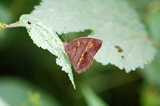
Mycalesis visala
Encyclopedia
The Long-brand Bushbrown (Mycalesis visala) is a species
of satyrine
butterfly
found in Asia
. It might include the Tamil Bushbrown as subspecies
.
. On the whole, however, M. visala runs larger, and as a rule both sexes (in the continental form, not in the insular race) can be discriminated from the males and females or allied forms by the shape of the fore wing. This is, as a rule, produced and acute at apex, with the tennen below sharply transverse. The males, moreover, have the sex-mark on the underside of the fore wing rather bright ochraceous and very long, extending beyond the transverse bands crossing the wings.
Race andamana, Moore. Male sex-mark on the underside of the fore wing as in M. visala. Shape of wings much more rounded in both seasonal forms of both sexes ; in this closely resembling M. mineus, but the ground-colour of the wings is darker and the ocelli proportionately larger. Disposition of the ocelli apparently quite constant. Upperside: fore wing—two ocelli, the posterior the larger; hind wing—none in the male, an obscure one in the female. Underside : both sexes, fore wing with two, hind wing with seven ocelli; the posterior four of the latter disposed as in M. mineus.
Species
In biology, a species is one of the basic units of biological classification and a taxonomic rank. A species is often defined as a group of organisms capable of interbreeding and producing fertile offspring. While in many cases this definition is adequate, more precise or differing measures are...
of satyrine
Satyrinae
Satyrinae, the satyrines or satyrids, commonly known as the Browns, is a subfamily of the Nymphalidae . They were formerly considered a distinct family, Satyridae. This group contains nearly half of the known diversity of brush-footed butterflies...
butterfly
Butterfly
A butterfly is a mainly day-flying insect of the order Lepidoptera, which includes the butterflies and moths. Like other holometabolous insects, the butterfly's life cycle consists of four parts: egg, larva, pupa and adult. Most species are diurnal. Butterflies have large, often brightly coloured...
found in Asia
Asia
Asia is the world's largest and most populous continent, located primarily in the eastern and northern hemispheres. It covers 8.7% of the Earth's total surface area and with approximately 3.879 billion people, it hosts 60% of the world's current human population...
. It might include the Tamil Bushbrown as subspecies
Subspecies
Subspecies in biological classification, is either a taxonomic rank subordinate to species, ora taxonomic unit in that rank . A subspecies cannot be recognized in isolation: a species will either be recognized as having no subspecies at all or two or more, never just one...
.
Description
In colour and the markings on the wings of both seasonal forms of M. visala closely resemble those of M. mineusMycalesis mineus
The Dark-branded Bushbrown, Mycalesis mineus, is a species of satyrine butterfly found in Asia.-Description:Wet-season form.— Upperside dark vandyke-brown; fore and hind wings with slender subterminai and terminal pale lines...
. On the whole, however, M. visala runs larger, and as a rule both sexes (in the continental form, not in the insular race) can be discriminated from the males and females or allied forms by the shape of the fore wing. This is, as a rule, produced and acute at apex, with the tennen below sharply transverse. The males, moreover, have the sex-mark on the underside of the fore wing rather bright ochraceous and very long, extending beyond the transverse bands crossing the wings.
Race andamana, Moore. Male sex-mark on the underside of the fore wing as in M. visala. Shape of wings much more rounded in both seasonal forms of both sexes ; in this closely resembling M. mineus, but the ground-colour of the wings is darker and the ocelli proportionately larger. Disposition of the ocelli apparently quite constant. Upperside: fore wing—two ocelli, the posterior the larger; hind wing—none in the male, an obscure one in the female. Underside : both sexes, fore wing with two, hind wing with seven ocelli; the posterior four of the latter disposed as in M. mineus.

